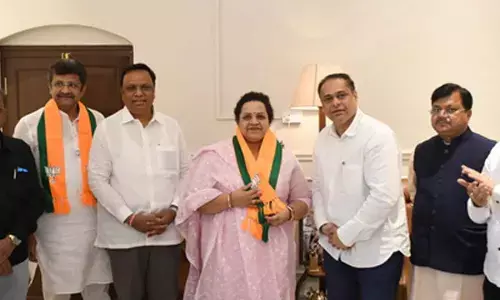Building exemplary alliance

The relationship between India-UAE is blossoming. The recent and first visit of Crown Prince of Abu Dhabi Sheikh Mohammed bin Zayed Al Nahyan to New Delhi to strengthen ties has added hope of new vigour and momentum to the relationship. The visit was a follow-up of Modi’s to Abu Dhabi in August last year, the first by an Indian Prime Minister after a gap of 34 years.
The relationship between India-UAE is blossoming. The recent and first visit of Crown Prince of Abu Dhabi Sheikh Mohammed bin Zayed Al Nahyan to New Delhi to strengthen ties has added hope of new vigour and momentum to the relationship. The visit was a follow-up of Modi’s to Abu Dhabi in August last year, the first by an Indian Prime Minister after a gap of 34 years.
Modi’s euphoria and promise of an India that was willing to think differently got a number of international interlocutors excited, including the UAE, which was seen appreciating his outreach after decades of neglect by New Delhi. This short and successful visit has thus energised this relationship further and UAE even made the commitment to support for India’s candidature for permanent membership of a reformed United Nations Security Council (UNSC).
India’s repositioning in the Gulf States began in the mid-2000s, when the nuclear deal with the US was being finalised. The UAE (and Saudi Arabia for that matter) started to take notice of India as an emerging actor. However with time, that process lost momentum. The Modi narrative had offered it a second chance and this was evident by the host of agreements being signed to boost cooperation in sectors like oil, nuclear energy, IT, aerospace, railways and electronics.
With External Affairs Minister Sushma Swaraj briefing the Prince on the Pathankot terrorist attacks and UAE expressing solidarity, there is ample scope for intelligence sharing and for cooperation on fighting religious radicalism that threatens the Arabian Sea community, of which India and UAE are a part. The two countries have also decided to collaborate in the spheres of cyber and maritime security in the region.
Ways to combat Islamic State, (IS) threat and containing radicalism besides situation in war-ravaged Syria figured prominently. Between Swaraj and Al Nahyan, the two leaders discussed the challenge posed by the IS, which has under its control vast swathes in Iraq and Syria, and emphasised the need to work closely to defeat terrorism. In this regard, Swaraj also complimented UAE for supporting the Comprehensive Convention on International Terrorism (CCIT) to effectively deal with the menace globally.
However, the UAE would not want this to be mixed up in a narrow game of one-upmanship between New Delhi and Islamabad. The interpretation of the August 2015 joint statement solely in terms of the “isolation” of Pakistan or “freezing of D Company assets” ended up creating irritants.
Another prominent dimension of attention is an estimated 2.6 million Indian Diaspora in the region. They remitted around $15 billion during 2015, which highlights the importance of the UAE-India ties. However, though professional Indians have migrated in recent years, the broader diaspora is still the working class. While this population serves India heroically in terms of remittances, it also clouds perceptions of how much India has changed in the past 15-20 years.
The policies made for this region are more Kerala centric and the politics of the State and the presence of an older generation of Indian deal-makers in Dubai have held the relationship hostage. Next, the decline in oil prices has had the UAE rethinking its economic future. The search is for solid, long term investments that provide steady returns.
As such, for India to limit the role of sovereign wealth funds from the Emirates to minor stakes in individual companies is self-defeating. There is a more ambitious appetite in the UAE, which will inevitably require a government-to-government arrangement.
For instance, the UAE has made massive investments in Serbian arms facilities, helping upgrade them and agreeing to buy back a quantum of the products. A similar arrangement with an Indian ordnance factory could be considered. Food security is another pressure point. There is room for UAE investment in modern contract farming in India, again with a long-term buy-back arrangement that will benefit the Indian farmer as well.
Dubai’s and Abu Dhabi’s experiences with urban planning could be put to good use in “smart cities” they choose to adopt and put their resources into. The mood is ripe for such interdependencies. Both counties have also engaged with each other further as economic and strategic partners. In line with it, a major focus of the visit by the UAE leader was also on significantly enhancing trade volume from current annual figure of $60 billion.
This target had been decided by Modi during his earlier visit and the two sides are drawing action plans to achieve it. The UAE-Indian ties have witnessed rapid growth over recent years, so much so India is the largest trading partner while the UAE is India’s third ranked partner after China and the US.
With the Chinese demand slowing, India has become a growing energy partner. It has become one of the significant importers of the UAE’s petroleum, petrochemical and aluminium products. A number of agreements were signed in oil, gas and renewable energy sector. Earlier, the two had even decided to promote a strategic partnership in the energy sector, including UAE’s participation in India in the development of strategic petroleum reserves, upstream and downstream petroleum sectors, and collaboration in third countries.
India imports about 270,000 of crude oil per day with the UAE being the sixth-largest supplier. A number of UAE companies have invested in India including in the energy sector. Abu Dhabi National Energy Company (Taqa) has a presence in India operating 250MW lignite-fired power plant in Neyveli, Tamil Nadu. Another power plant of the company in Himachal Pradesh has commenced operations last year.
The two sides agreed to enhance cooperation in space science and technology and to explore a long-term plan to identify cooperation projects in areas of mutual interest. They expressed satisfaction at the active engagement between the UAE Space Agency and the Indian Space Research Organisation (ISRO), which has led to the signing of a MoU and the establishment of a Joint Working Group for space cooperation. Modi welcomed UAE’s plan to set up West Asia’s first Space Research Centre at AI Ain and plans to launch a Mars Mission in 2021.
Over thousands of years, the two countries have forged a robust relationship based on trade and commerce. Currency also played its part in knitting the two together when, for a few decades in the mid-20th century, the seven emirates adopted the Indian rupee as its legal tender. It is illustrative of how the destinies of the two nations were frequently and tightly intertwined. Time has come to reactivate this relationship so that it becomes long term and mutually awarding for both the players.
Amrita Banerjee (The author is a research scholar in International relations at School of International Studies, JNU)
Source: INFA
Woman injured in stabbing attack in Tokyo, suspect at large
Bengal cop booked for murder over mysterious death of woman home guard, SIT to probe case
Staffer recalls horror of 7-kg gold robbery by armed gang in Karnataka’s Hunsur
25-Year-Old Airline Cabin Crew Member Dies At Gurugram Party; Police Begin Investigation
















